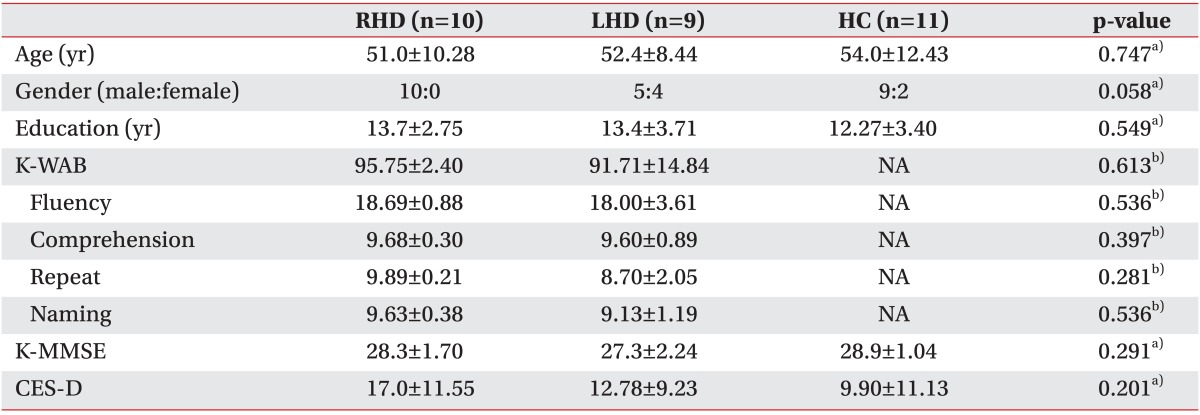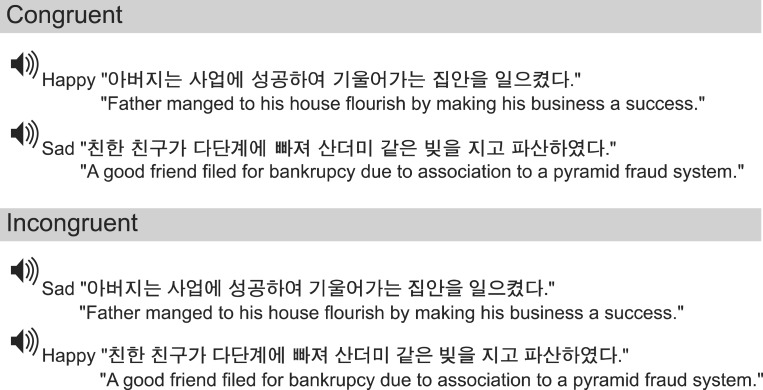1. Heilman KM, Scholes R, Watson RT. Auditory affective agnosia: disturbed comprehension of affective speech. J Neurol Neurosurg Psychiatry. 1975; 38:69–72. PMID:
1117301.

2. Monrad-Krohn GH. Dysprosody or altered melody of language. Brain. 1947; 70:405–415. PMID:
18903253.

3. Ross ED. The aprosodias: functional-anatomic organization of the affective components of language in the right hemisphere. Arch Neurol. 1981; 38:561–569. PMID:
7271534.
4. Ley RG, Bryden MP. A dissociation of right and left hemispheric effects for recognizing emotional tone and verbal content. Brain Cogn. 1982; 1:3–9. PMID:
6927552.

5. Paulmann S, Kotz SA. An ERP investigation on the temporal dynamics of emotional prosody and emotional semantics in pseudo- and lexical-sentence context. Brain Lang. 2008; 105:59–69. PMID:
18177699.

6. Buchanan TW, Lutz K, Mirzazade S, Specht K, Shah NJ, Zilles K, et al. Recognition of emotional prosody and verbal components of spoken language: an fMRI study. Brain Res Cogn Brain Res. 2000; 9:227–238. PMID:
10808134.

7. Gandour J, Wong D, Dzemidzic M, Lowe M, Tong Y, Li X. A cross-linguistic fMRI study of perception of intonation and emotion in Chinese. Hum Brain Mapp. 2003; 18:149–157. PMID:
12599272.

8. George MS, Parekh PI, Rosinsky N, Ketter TA, Kimbrell TA, Heilman KM, et al. Understanding emotional prosody activates right hemisphere regions. Arch Neurol. 1996; 53:665–670. PMID:
8929174.

9. Kotz SA, Meyer M, Alter K, Besson M, von Cramon DY, Friederici AD. On the lateralization of emotional prosody: an event-related functional MR investigation. Brain Lang. 2003; 86:366–376. PMID:
12972367.

10. Pell MD. Cerebral mechanisms for understanding emotional prosody in speech. Brain Lang. 2006; 96:221–234. PMID:
15913754.

11. Friederici AD, Alter K. Lateralization of auditory language functions: a dynamic dual pathway model. Brain Lang. 2004; 89:267–276. PMID:
15068909.

12. Mitchell RL, Elliott R, Barry M, Cruttenden A, Woodruff PW. The neural response to emotional prosody, as revealed by functional magnetic resonance imaging. Neuropsychologia. 2003; 41:1410–1421. PMID:
12757912.

13. Woldorff MG, Gallen CC, Hampson SA, Hillyard SA, Pantev C, Sobel D, et al. Modulation of early sensory processing in human auditory cortex during auditory selective attention. Proc Natl Acad Sci U S A. 1993; 90:8722–8726. PMID:
8378354.

14. Kitayama S, Ishii K. Word and voice: spontaneous attention to emotional utterances in two languages. Cogn Emot. 2002; 16:29–59.

15. Ishii K, Reyes JA, Kitayama S. Spontaneous attention to word content versus emotional tone: differences among three cultures. Psychol Sci. 2003; 14:39–46. PMID:
12564752.
16. Peron J, El Tamer S, Grandjean D, Leray E, Travers D, Drapier D, et al. Major depressive disorder skews the recognition of emotional prosody. Prog Neuropsychopharmacol Biol Psychiatry. 2011; 35:987–996. PMID:
21296120.
17. Schlipf S, Batra A, Walter G, Zeep C, Wildgruber D, Fallgatter A, et al. Judgment of emotional information expressed by prosody and semantics in patients with unipolar depression. Front Psychol. 2013; 4:461. PMID:
23888149.

18. Schirmer A, Kotz SA. ERP evidence for a sex-specific stroop effect in emotional speech. J Cogn Neurosci. 2003; 15:1135–1148. PMID:
14709232.

19. Paulmann S, Pell MD, Kotz SA. How aging affects the recognition of emotional speech. Brain Lang. 2008; 104:262–269. PMID:
17428529.

20. Ross ED, Monnot M. Affective prosody: what do comprehension errors tell us about hemispheric lateralization of emotions, sex and aging effects, and the role of cognitive appraisal. Neuropsychologia. 2011; 49:866–877. PMID:
21182850.

21. Schirmer A, Kotz SA, Friederici AD. On the role of attention for the processing of emotions in speech: sex differences revisited. Brain Res Cogn Brain Res. 2005; 24:442–452. PMID:
16099357.






 PDF
PDF ePub
ePub Citation
Citation Print
Print






 XML Download
XML Download